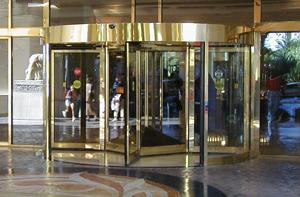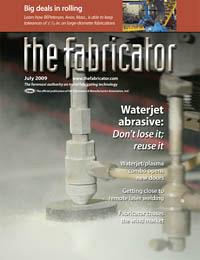Senior Editor
- FMA
- The Fabricator
- FABTECH
- Canadian Metalworking
Categories
- Additive Manufacturing
- Aluminum Welding
- Arc Welding
- Assembly and Joining
- Automation and Robotics
- Bending and Forming
- Consumables
- Cutting and Weld Prep
- Electric Vehicles
- En Español
- Finishing
- Hydroforming
- Laser Cutting
- Laser Welding
- Machining
- Manufacturing Software
- Materials Handling
- Metals/Materials
- Oxyfuel Cutting
- Plasma Cutting
- Power Tools
- Punching and Other Holemaking
- Roll Forming
- Safety
- Sawing
- Shearing
- Shop Management
- Testing and Measuring
- Tube and Pipe Fabrication
- Tube and Pipe Production
- Waterjet Cutting
Industry Directory
Webcasts
Podcasts
FAB 40
Advertise
Subscribe
Account Login
Search
Counting on the combo
Revolving door-maker adds flexibility with waterjet/plasma combination machine
- By Tim Heston
- July 1, 2009
- Article
- Waterjet Cutting

Figure 1Boon Edam produces a variety of revolving doors that have some unique fabrication requirements.
Next time you enter a downtown hotel or office building, push the revolving door—then look up. There you'll see what the door industry calls ceiling pies, wedge-shaped pieces assembled into a round disk. Each may have a collection of small holes used for speakers, security sensors, or other purposes. If the door is new and came from Boon Edam, those pies likely spent some time on a combination waterjet/plasma machine.
From Turnstiles to Revolving Doors
A Dutch company with U.S. operations in Lillington, N.C., Boon Edam has been in the revolving-door business for more than a century. The company makes doors for business offices, hotels, and restaurants (see Figure 1). It also has waded deep into the security market, providing secure entrances for airports, financial institutions, and organizations such as the FBI and the Centers for Disease Control and Prevention. Such doors can have a variety of features, from card-swipe units to sophisticated biometric identification systems. They even can be bullet-resistant.
vFor most of its history the North Carolina facility, previously owned by Tomsed Corp., produced security-entrance turnstiles and barriers. In 2005 Royal Boon Edam Group acquired Tomsed and moved the North Carolina operations into a new, 300,000-square-foot plant. The facility today employs 120 and serves as Boon Edam's primary manufacturer for all turnstiles worldwide while also meeting almost all domestic revolving-door demand.The shop floor is a high-mix environment. Revolving doors and turnstiles come in many shapes and sizes suited to meet the application, and door diameters can range from 6 to 10 ft., or even more. So the shop's equipment has to be ready for anything, including a range of cut-edge requirements.
Choosing a Combo
From the get-go Boon Edam managers knew that waterjet technology would serve them well. For one, it provided the precision they needed for certain contours and geometries, such as those small holes in the ceiling pies. What really tipped the scale toward waterjet, though, was the mix of materials that flow through the plant, everything from galvanized plates to Baltic birch laminate to Muntz metal (which consists of 60 percent copper and the rest zinc with a trace of iron). Some of the company's bullet-resistant doors are made of a special fiber-glass material. And only a waterjet can cut all of it.
Nevertheless, what a shop gains from waterjet's accuracy and flexibility, it gives up in its relatively slow speed, and Boon Edam didn't need waterjet's precision for every cut. Those ceiling pies, for instance, have precision holes that require the waterjet. For the perimeter cuts, which are bent to two 90-degree angles and aren't visible in the final assembly, plasma technology suffices.
Why invest in a waterjet/plasma combination machine when two separate machines would give a shop more cutting hours? According to Jim Sheehan, manufacturing engineer, all that cutting capacity means nothing if it doesn't reduce the time it takes for a product to flow through manufacturing, assembly, and packaging.
Cutting previously was outsourced to a shop with laser cutting capability. So why not choose a laser for the in-house operation? "We knew we had applications for plasma, waterjet, and laser," Sheehan explained. "We considered all the possibilities. The laser had a significantly higher cost and required high volume to be economical."
About 60 percent of the cuts require the waterjet, while the remaining 40 percent use the plasma torch. Edge-quality requirements determine which process to use. The waterjet handles the critical cuts, like the holes in the ceiling pies, and the faster plasma handles the rest, such as part perimeters, without shifting the plate from machine to machine.
Outsourcing the cutting added two to three weeks to the lead-time as well as logistical complexity, which meant a sizable parts inventory simply was unavoidable to ensure quick response to customer demand. According to Sheehan, bringing fabrication in-house and cutting components like ceiling pies on one machine increased throughput by almost a factor of 10. "With one program we're able to cut the finer edge quality with the waterjet and immediately switch over to the plasma to finish the job," he said, "so taking advantage of the combination technology is ideal."
Boon Edam's cutting system, an ESAB Hydrocut LR 14, is a low-rail, large-gantry machine that can be equipped with up to four waterjet heads as well as multiple plasma or other process tools (see Figure 2). The gantry features welded, stress-relieved, reinforced components as well as an independent reinforced deck that supports auxiliary equipment without placing additional torsional forces on the main beam. The system also has ESAB's Vision 52™ CNC for motion and process control. The technology allows for remote access, so that the vendor can log in through a modem and take control of the machine to diagnose and fix a problem.
Process control for any material can be set up by selecting the material type and thickness, and information from CAD files can be driven through a postprocessor and sent directly to the machine. The capability helps when programming parts for the canopy, the large, round part placed on top of the revolving door. Boon Edam offers, among other options, custom aluminum canopies in three different heights. Previously these were cut with a milling machine or table saw, both of which created some quality and safety issues. Today, "we can put the width into the program, and the waterjet will cut the piece to the exact height needed," Sheehan said.
Besides the ceiling pies, the system cuts galvanized, semicircular plate components that are placed above its full-height revolving-turnstile systems, which control access in places like sports stadiums and train platforms. The plasma cuts out the plate blank and six noncritical, unexposed holes, while the waterjet cuts four visible features. Into some holes go fasteners that hold indicator lights and other items, depending on the door model, and the holes must be precise to ensure a tight fit.
For all metal visible to those walking through a revolving door, cosmetics are paramount. These areas often have material clad with stainless steel, Muntz, or other metal, and all of this is processed by the waterjet. "It was quite expensive to outsource this," Sheehan said. "Now we're able to do all of that waterjet in-house. And all of those are brake shapes. They come off the waterjet and go right to the press brake, and when finished, they go right over to the assembly area."
When structural components are completed in other areas of the shop, so are the specialized pieces from the fabrication cell. With fabrication capability under Boon Edam's roof, parts reach assembly when they're needed—within about a day.
Maximizing Labor's Value
Sheehan didn't sugarcoat reality. Because of the construction downturn, 2009 hasn't been easy for the company, he said. But the door manufacturer is sustaining by, among other things, ensuring smooth part flow and getting the most value it can out of skilled labor. For instance, the fabrication operation groups the waterjet/plasma and a 180-ton press brake into a single cell.
As Sheehan explained, "In this cell, one operator runs the waterjet/ plasma system, and while the machine is running, he's either pulling pieces off and taking them directly to the press brake, and bending them; or he may empty the last table load, be working on those through the press brake, while the next table load is being cut on the waterjet/plasma machine. So we're taking advantage of the cycle time and adding value with the same labor resource."
And getting the most out of everyone on the floor is never a bad thing, in good economic times or bad.
Packing It Right
Bringing fabrication in-house helped Boon Edam eliminate long lead-times for outsourced parts and the need to keep parts in inventory—and it also solved another problem at the packaging end of the operation. Previously workers spent hours securing finished door kits into shipping containers, and nothing was standard. Sometimes door kits would arrive jostled and broken. All the manufacturing efficiency in the world doesn't mean a thing if the product breaks en route to the customer.
Now the company uses custom plastic shapes for easier and more secure door packing, which has reduced shipping damage significantly. The company waterjet-cuts the black, high-density polyethylene dust covers that protect a revolving door's operating components, material that used to be cut on band saws using specialized jigs, "which was problematic, to say the least," Sheehan recalled.
Within the leftover polyethylene skeleton, programmers nest those packing components. "We now have customized the door packaging using some of the material that we used to throw out," Sheehan said. "We've really enhanced the final packaging of our product."
About the Author

Tim Heston
2135 Point Blvd
Elgin, IL 60123
815-381-1314
Tim Heston, The Fabricator's senior editor, has covered the metal fabrication industry since 1998, starting his career at the American Welding Society's Welding Journal. Since then he has covered the full range of metal fabrication processes, from stamping, bending, and cutting to grinding and polishing. He joined The Fabricator's staff in October 2007.
Related Companies
subscribe now

The Fabricator is North America's leading magazine for the metal forming and fabricating industry. The magazine delivers the news, technical articles, and case histories that enable fabricators to do their jobs more efficiently. The Fabricator has served the industry since 1970.
start your free subscription- Stay connected from anywhere

Easily access valuable industry resources now with full access to the digital edition of The Fabricator.

Easily access valuable industry resources now with full access to the digital edition of The Welder.

Easily access valuable industry resources now with full access to the digital edition of The Tube and Pipe Journal.
- Podcasting
- Podcast:
- The Fabricator Podcast
- Published:
- 04/16/2024
- Running Time:
- 63:29
In this episode of The Fabricator Podcast, Caleb Chamberlain, co-founder and CEO of OSH Cut, discusses his company’s...
- Trending Articles
How to set a press brake backgauge manually

Capturing, recording equipment inspection data for FMEA

Tips for creating sheet metal tubes with perforations

Are two heads better than one in fiber laser cutting?

Hypertherm Associates implements Rapyuta Robotics AMRs in warehouse

- Industry Events
16th Annual Safety Conference
- April 30 - May 1, 2024
- Elgin,
Pipe and Tube Conference
- May 21 - 22, 2024
- Omaha, NE
World-Class Roll Forming Workshop
- June 5 - 6, 2024
- Louisville, KY
Advanced Laser Application Workshop
- June 25 - 27, 2024
- Novi, MI


























